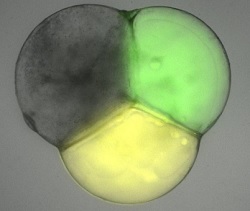 |
| Artificial cell with multiple compartments--Courtesy of Imperial College London |
Cells in nature are able to split up their contents into separate compartments to perform distinct functions for the overall performance of the cell. With this in mind, can drug delivery systems mimic these cells to perform multiple tasks at the same time?
Researchers at Imperial College London have created an artificial cell with separate compartments that can communicate with one another via chemical reactions, much the way, for instance, the nucleus would communicate with other parts of the cell. To this end, the drug vehicle could ultimately perform such tasks as producing proteins and enzymes for a "smart" delivery system, according to a report from the college.
"Imagine the cell is like a house," lead researcher Dr. Oscar Ces said in a statement. "Every house has walls, rooms and doors. In the past we have only been able to build the outside of the house. But with our new technique, not only have we built the rooms inside the house, we've built the doors so you can travel through the house and get into the next room."
The scientists constructed the cells using microdroplets made of oil and water, and when they came together, they attached to one another much the way soap bubbles form complexes on water surfaces.
In the case of this study, published in the journal Nature Communications, the first droplet contained the digestive enzyme lactase, which breaks sugar down into glucose. The glucose passed through a protein pore into the next compartment, where it reacted with oxygen to produce hydrogen peroxide. In the third compartment, the hydrogen peroxide reacted with another enzyme to produce an orange fluorescence, demonstrating that all of the reactions happened as planned.
"So far we have been able to make artificial cells reproduce, make artificial cells communicate with each other, and even make artificial cells metabolise and produce their own energy," co-author Dr. Rob Law said. "But these are 'one-pot' processes and bringing together isolated processes and functions within one cell has eluded us. So replicating natural cell compartmentalisation in an artificial environment is a big step forward for synthetic biology."
- here's the Imperial College London report
- and here's the abstract